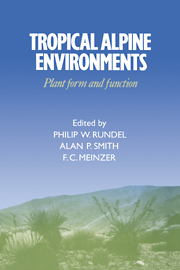Book contents
- Frontmatter
- Contents
- List of contributors
- Preface
- 1 Introduction to tropical alpine vegetation
- 2 Tropical alpine climates
- 3 Páramo microclimate and leaf thermal balance of Andean giant rosette plants
- 4 Comparative water relations of tropical alpine plants
- 5 Cold tolerance in tropical alpine plants
- 6 Anatomy of tropical alpine plants
- 7 Environmental biology of a tropical treeline species, Polylepis sericea
- 8 Morphological and physiological radiation in páramo Draba
- 9 Sediment-based carbon nutrition in tropical alpine Isoetes
- 10 Functional significance of inflorescence pubescence in tropical alpine species of Puya
- 11 Turnover and conservation of nutrients in the pachycaul Senecio keniodendron
- 12 Soil nutrient dynamics in East African alpine ecosystems
- 13 An overview of the reproductive biology of Espeletia (Asteraceae) in the Venezuelan Andes
- 14 Population biology of Mount Kenya lobelias
- 15 Population biology of Senecio keniodendron (Asteraceae), an Afroalpine giant rosette plant
- 16 Population dynamics and flowering in a Hawaiian alpine rosette plant, Argyroxiphium sandwicense
- 17 Plant form and function in alpine New Guinea
- 18 Alpine herbivory on Mount Kenya
- 19 Biotic interactions in Hawaiian high elevation ecosystems
- 20 Tropical alpine ecology: progress and priorities
- Index
10 - Functional significance of inflorescence pubescence in tropical alpine species of Puya
Published online by Cambridge University Press: 21 October 2009
- Frontmatter
- Contents
- List of contributors
- Preface
- 1 Introduction to tropical alpine vegetation
- 2 Tropical alpine climates
- 3 Páramo microclimate and leaf thermal balance of Andean giant rosette plants
- 4 Comparative water relations of tropical alpine plants
- 5 Cold tolerance in tropical alpine plants
- 6 Anatomy of tropical alpine plants
- 7 Environmental biology of a tropical treeline species, Polylepis sericea
- 8 Morphological and physiological radiation in páramo Draba
- 9 Sediment-based carbon nutrition in tropical alpine Isoetes
- 10 Functional significance of inflorescence pubescence in tropical alpine species of Puya
- 11 Turnover and conservation of nutrients in the pachycaul Senecio keniodendron
- 12 Soil nutrient dynamics in East African alpine ecosystems
- 13 An overview of the reproductive biology of Espeletia (Asteraceae) in the Venezuelan Andes
- 14 Population biology of Mount Kenya lobelias
- 15 Population biology of Senecio keniodendron (Asteraceae), an Afroalpine giant rosette plant
- 16 Population dynamics and flowering in a Hawaiian alpine rosette plant, Argyroxiphium sandwicense
- 17 Plant form and function in alpine New Guinea
- 18 Alpine herbivory on Mount Kenya
- 19 Biotic interactions in Hawaiian high elevation ecosystems
- 20 Tropical alpine ecology: progress and priorities
- Index
Summary
Introduction
Tropical alpine environments are extreme and can generate very powerful selection pressures. Because of their simplicity they can provide valuable models for the study of evolution (Bradshaw 1971). The arborescent rosette growth form is a dominant feature across tropical alpine landscapes and has been the subject of detailed comparative ecological studies (Smith 1979, 1980, 1981; Smith & Young 1982; Young 1985 and Chapter 14). Alpine plant communities of most tropical alpine regions are distinguished from those of temperate latitudes by the presence of these giant rosette plants (Hedberg 1964; Cuatrecasas 1968; Smith 1981), with each major region possessing a unique flora. It has been assumed that the giant rosette form is an adaptive response to tropical alpine environments (Hedberg 1964; Mabberley 1973; Smith 1981), and an example of convergent evolution by different plant families to similar ecological conditions.
A notable feature of tropical alpine systems worldwide is the prevalence of pubescence, particularly among arborescent rosette plants. Most giant rosettes, including Senecio and Lobelia in Afroalpine areas (Hedberg 1964), Lupinus, Espeletia and Puya in the páramos of South America (Heilborn 1925; Smith 1981; Miller 1986), and Argyroxiphium in Hawaii (Carlquist 1974 and Chapter 16), produce dense pubescence on their leaves and/or inflorescences.
- Type
- Chapter
- Information
- Tropical Alpine EnvironmentsPlant Form and Function, pp. 195 - 214Publisher: Cambridge University PressPrint publication year: 1994
- 12
- Cited by

